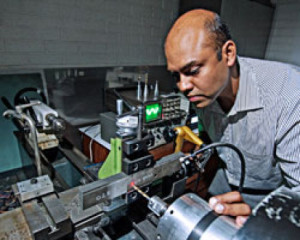 Researchers at Loughborough University have made important advances that may dramatically change how cutting, drilling and milling is done in manufacturing. The tool makes working on difficult-to-cut materials like aerospace-grade composites so easy it is like ‘cutting through butter’.
Researchers at Loughborough University have made important advances that may dramatically change how cutting, drilling and milling is done in manufacturing. The tool makes working on difficult-to-cut materials like aerospace-grade composites so easy it is like ‘cutting through butter’.
It involves a technique called ultrasonically-assisted machining (UAM), which uses a specially designed piezoelectric transducer working in tandem with a traditional turning, drilling or milling machine. The device creates ultrasonic vibrations at anything between 20kHz and 39kHz, and the machining technique makes the composite material so ‘soft’ in the area being worked on that much less force is needed from the cutting tool, resulting in less damage, less waste, and a better finish.
UAM is the brainchild of Professor Vladimir Babitsky, from the Wolfson School of Mechanical and Manufacturing Engineering, and has been developed extensively in the last few years with the support of Dr Anish Roy and Professor Vadim Silberschmidt. Several PhD projects have been successful over the last decade, including the recent work by Vaibhav Phadnis and Farrukh Makhdum, who have been instrumental in tackling the challenging task of drilling in carbon/epoxy composites. Vaibhav worked on composites and believes that when the device has been perfected for other materials, like Ni-alloys, it will be a major boost for manufacturers. Dr Roy said: “UK manufacturing production and new orders both continue to rise. This is truly encouraging which implies we ought to be looking for better, economically efficient and sustainable manufacturing methods in the immediate to near future.
“Ultrasonically assisted machining could well be the answer to this. The technique has been successful in the laboratory where multi-fold improvements in cutting intractable aerospace alloys have been demonstrated. It makes machining so easy it is like cutting through butter. Ultrasonically assisted drilling has shown significant improvements in drilling carbon/epoxy composites with significantly reduced damage in the machined composite. This is particularly interesting, as any kind of machining of brittle composites can damage the composite material. The challenge is to minimise this and, if possible, completely eliminate damage due to drilling. Ultrasonic drilling has shown excellent damage mitigation with remarkable drilling force reductions.”
The technique is currently being extended into biomedical applications such as drilling holes in bones for orthopedic surgery. Also, preliminary studies in drilling tiny holes in printed circuit boards show excellent potential for component assembly that require high precision.



